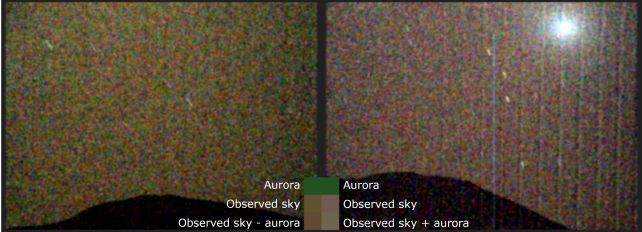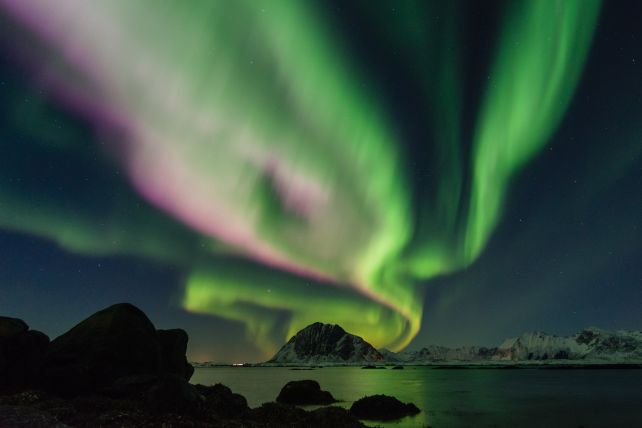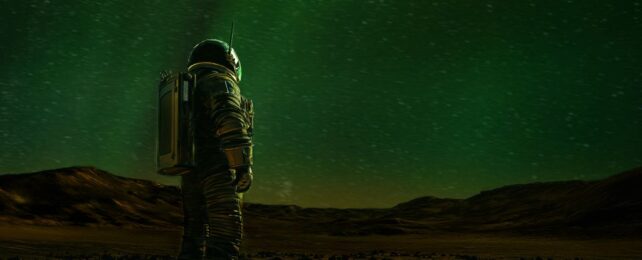An aurora gently glowing in wavelengths visible to the human eye has been captured on Mars for the first time – and a robot was the only one to see it live.
On 18 March 2024, as the night sky over Jezero Crater turned a faint, luminous green, the Perseverance rover sat ready with its eyes peeled. What it recorded opens new ways to study Mars. Although Mars is known to have auroras of various kinds, all the others we've seen have been in invisible hues of ultraviolet.
"Auroras are the visible manifestations of how our Sun affects planets. The confirmation that visible auroras on Mars exist opens up new, hopefully simpler and cheaper, ways that we can study these processes," physicist Elise Wright Knutsen of the University of Oslo explained to ScienceAlert.
"So far we have only reported our very first detection of this green emission, but observations of auroras can tell us a lot about how the Sun's particles are interacting with Mars's magnetosphere and upper atmosphere."

Every planet in the Solar System has its own type of aurora, but the auroras on Mars are something really interesting. Auroras are the result of energetic interactions between extraplanetary and planetary particles (usually atmospheric, but not always), mediated by a magnetic field.
Particles (usually from the Sun, but not always) are guided by the field towards the planet (usually the poles, but not always) where they collide with other materials, knocking about electrons and creating a glow in wavelengths that depend on the conditions.
The atmosphere of Mars is very thin, roughly 2 percent of the density of Earth's. Moreover, the red planet has, at best, a patchy and feeble magnetic field that hangs around only certain localized areas, where magnetized minerals in the crust preserve remnants of the magnetic field Mars once had. It's nothing like the glorious magnetospheric bubble protecting Earth.

Nevertheless, these localized patches of magnetic field are sufficient for auroral activity. When the solar wind blows the right way, atmosphere near these magnetic patches glow in ultraviolet wavelengths. Studying these UV auroras, Knutsen and her colleagues realized there was more to the activity in the Martian atmosphere than we could see.
"We've been observing auroras at Mars for 20 years, but all of it has been at ultraviolet wavelengths. Depending on which energy level the electron transitions back to, we get auroral emissions with different wavelengths/colors," Knutsen explained.
"When we see a specific wavelength, we can use quantum mechanics to figure out if that transition shares an upper state with any other transitions. If it does, then we know auroras at other wavelengths should also be present, even if we don't observe them directly. So, observations of a specific UV emission (at 297 nanometers) from an atomic oxygen transition led us to believe that emission of green light should also be present."

Inspired by what they found, Knutsen and her colleagues went hunting for the light. This was not really a simple matter, though. Most of the visible-light instruments on Mars are designed for making observations during the day, not for looking for a really faint glow in the night sky.
In addition, auroras on Mars are much fainter than those on Earth. The best time to try and catch one is right after a particularly energetic solar outburst, such as a coronal mass ejection. This means that you need to be ready to act quickly. Mars satellites are not designed for such spontaneity.
However, for the coronal mass ejection of 15 March 2024, all the pieces fell into place. Perseverance has instruments capable of detecting the light the researchers were looking for – and a team of scientists at the helm ready and willing to pivot to get the necessary observations.
So, several days after a huge eruption saw billions of tons of charged particles leave the Sun, the researchers recorded what they were looking for: an excess light in the night sky of Mars at the 557.7-nanometer wavelength – the visible glow of ionized oxygen.

Because it's Mars, the sight was not what we see on Earth.
"The green aurora on Mars has exactly the same color as the green aurora on Earth, but it still looks completely different," Knutsen said. "We are used to seeing very structured ribbons with a distinct shape. The green aurora on Mars however is more or less completely uniform. The whole sky glows green, in all directions, no matter if you're standing on the equator or closer to the poles."
Although, she adds, we may not be able to see it with our own eyes even if we were standing on Mars, since the human eye doesn't discern color well in dim light. It will be interesting to learn what the first Mars explorers experience, when they finally get there.
The detection was the team's fourth attempt to catch the phenomenon in action using Perseverance, so there seems to be some other factors at play in whether or not a solar sneeze produces a visible aurora on Mars. The team plans to try catching more of them to figure out how auroras happen on Mars, and to see some of the patterns that may emerge.
"I'm incredibly excited by the further research that opens up with this discovery, I'm very interested in figuring out which types of solar storms cause this aurora and so on," Knutsen said. "But also, it is just super fun to picture the red planet glowing green!"
The research has been published in Science Advances.
